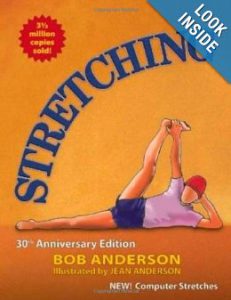Stretching by Bob Anderson

![]()
I’ve had a lot of questions recently about how to stretch a child with an early neurologic injury. Stretching used to be a mainstay of physical therapy, but it seems to have dropped out of the repertoire of many therapists nowadays. A peak performance athlete knows to stretch before and after any activity and does so religiously. Athletes that do not stretch are athletes that are going to be injured. Yet the majority of children go to a therapy session and are not stretched either before or after an intensive period of therapeutic exercise. Tight muscles do not work as well as flexible muscles. You don’t have to have spasticity in order to be tight. Any problem that causes muscle weakness will also result in tighter muscles as the body stiffens up in an attempt to increase strength during movement.
I have consulted several therapists about books for parents about stretching and all recommended Bob Anderson’s classic, first published in 1980 with an anniversary edition in 2010. He has an easy warm-up called Getting Started that I suggest parents do after reading his introductory comments on how to do stretching properly. I do not believe you should stretch a child unless you know what stretching feels like in your own body. Equally a therapist cannot teach how to stretch properly unless he or she also knows what stretching feels like. When stretching is done properly, it is enjoyable. For a child with an early neurologic issue, stretching is a technique that allows them to increase their body awareness and to learn how to differentiate between when their muscles are tight and when they are more relaxed.
I particularly want you to read the section on the stretch reflex found on page 13 of the Anderson book. Overstretching a muscle by going as far as you can go or bouncing in the position of stretch strains the muscles and activates the stretch reflex. For a child with spasticity, the stretch reflex is also activated if you stretch the muscle too far or too quickly. Stretching should never cause pain because pain activates the stretch reflex. I know as I am writing this that I’m going to receive a fair number of comments from parents who tell me that their child cries through the stretching routine and that is why they do not stretch. If the child cries, the stretch is not being done properly. Remember, the tighter the child, the more they need the muscles and tendons warmed up before a stretch. (Muscle Imbalance Hurts Growing Bodies)
I think Bob Anderson’s book is an invaluable resource and strongly suggest that every family get one for themselves and another for their favorite physical therapist. The stretching routines in the book are all for adults with normal bodies. This means that your therapist will have to read it and figure out which of the muscles your child needs to have stretched and how the stretches may need to be modified. You may need to use some aids such as pillows or bolsters to maintain body alignment during the stretch, but the key is to find the way that works best and then do it regularly. An occasional stretch is fairly useless.
Just a quick reminder, Kinesio Taping In Pediatrics by Patricia Martin and Audrey Yasukawa is another valuable resource that parents and their therapist should have in their collection of resource books. (Kinesio Taping In Pediatrics) The combination of a good stretching routine and intermittent taping can improve body alignment and flexibility in all of us. The earlier you get started, the better.
As ever, I look forward to your comments and questions.